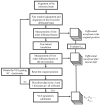Self-Calibration of a Large-Scale Variable-Line-Spacing Grating for an Absolute Optical Encoder by Differencing Spatially Shifted Phase Maps from a Fizeau Interferometer
- PMID: 36502050
- PMCID: PMC9736133
- DOI: 10.3390/s22239348
Self-Calibration of a Large-Scale Variable-Line-Spacing Grating for an Absolute Optical Encoder by Differencing Spatially Shifted Phase Maps from a Fizeau Interferometer
Abstract
A new method based on the interferometric pseudo-lateral-shearing method is proposed to evaluate the pitch variation of a large-scale planar variable-line-spacing (VLS) grating. In the method, wavefronts of the first-order diffracted beams from a planar VLS grating are measured by a commercial Fizeau form interferometer. By utilizing the differential wavefront of the first-order diffracted beam before and after the small lateral shift of the VLS grating, the pitch variation of the VLS grating can be evaluated. Meanwhile, additional positioning errors of the grating in the lateral shifting process could degrade the measurement accuracy of the pitch variation. To address the issue, the technique referred to as the reference plane technique is also introduced, where the least squares planes in the wavefronts of the first-order diffracted beams are employed to reduce the influences of the additional positioning errors of the VLS grating. The proposed method can also reduce the influence of the out-of-flatness of the reference flat in the Fizeau interferometer by taking the difference between the measured positive and negative diffracted wavefronts; namely, self-calibration can be accomplished. After the theoretical analysis and simulations, experiments are carried out with a large-scale VLS grating to verify the feasibility of the proposed methods. Furthermore, the evaluated VLS parameters are verified by comparing them with the readout signal of an absolute surface encoder employing the evaluated VLS grating as the scale for measurement.
Keywords: diffraction gratings; interferometric pseudo-lateral-shearing method; interferometry; optical encoder; self-calibration; variable-line-spacing grating.
Conflict of interest statement
The authors declare no conflict of interest.
Figures



















References
-
- Gao W., Kim S.W., Bosse H., Haitjema H., Chen Y.L., Lu X.D., Knapp W., Weckenmann A., Estler W.T., Kunzmann H. Measurement technologies for precision positioning. CIRP Ann. Manuf. Technol. 2015;64:773–796. doi: 10.1016/j.cirp.2015.05.009. - DOI
-
- Vishnyakov E.A., Kolesnikov A.O., Pirozhkov A.S., Ragozin E.N., Shatokhin A.N. Aperiodic reflection diffraction gratings for soft X-ray radiation and their application. Quantum Electron. 2018;48:916–929. doi: 10.1070/QEL16707. - DOI
MeSH terms
Grants and funding
LinkOut - more resources
Full Text Sources

